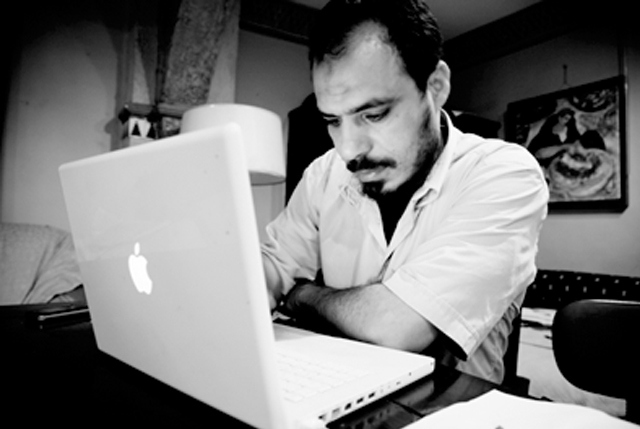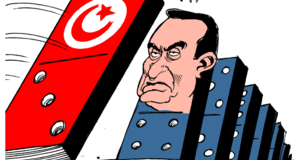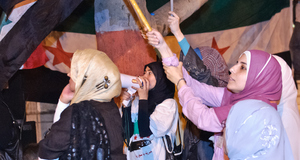From Cornell International Affairs Review VOL. 5 NO. 1The Evolution of Revolution: Social Media in the Modern Middle East and its Policy ImplicationsRegulators on Social Media in the Middle EastTo explain the degree of social media availability in authoritarian regimes, scholars need a common schema. This paper adapts Lawrence Lessig’s framework of regulation to examine the relationship between social media and political dissidence (Lessig 1999). Lessig’s framework uses a highly adaptable four-variable system that shows how forces regulate an object, in this case, social media.11 Syria, a country that is infamous for its systematic repression and killing of at least 3500 of its own citizens since March 2011, is a suitable environment to test this framework. Lessig’s framework calls for examining law, markets, norms, and architecture in a holistic analysis to gauge the degree to which these factors ease or hamper use of social media. This paper assumes that increased use of social media leads to an increase in civil discourse, which in turn allows for an increased degree of political dissent. Efforts to spread dissidence in Syria reflect social media efforts in other protests such as Wael Ghonim’s memorial page “We Are All Khaled Saeed” on Facebook. Another example is the page “We Are All Child Martyr Hamza Alkhateeb” which serves as a hub to memorialize the 13-year-old who was tortured and killed by Syrian police after participating in a protest in the province of Dar’a in April.12 By implementing Lessig’s framework, one can see more clearly what barriers the page’s administrator faces to maintain the site, which publishes a barrage of anti-government information and news daily.13 In Syria, an authoritarian regime that Reporters Without Borders bestowed the unenviable distinction of being among the “enemies of the internet,” there are no shortage of laws abridging free use of social media. Laws, Lessig’s first category, regulate usage of social media by threatening punishment for the defiance of a command. The state in question has the agency here, especially given President Assad’s continued ignorance of international law during the crackdown. Syria’s four-year ban on Facebook ended on February 9 2011, and there are now over 580,000 users in the country.14 The publisher of a revolutionary-sympathetic page like Hamza Alkhateeb’s would no doubt be cognizant of the specter of criminal prosecution, harassment, and torture if he or she resided in Syria. There have been many reports of security services demanding certain users’ Facebook passwords.14 Offline print and publication law is extended to online publishing in Syria, and comes with heavy restrictions on criticism of the regime. Though President Assad ended the emergency rule that since 1963 had banned public demonstrations, placed the media in control of the state, and allowed it to spy on its own citizens, if anything laws regulating the use of social media and the internet have increased in rigidity and scope.15 On 28 August 2011 Syria strengthened its regulation of free speech by introducing a law mandating “responsible freedom of expression.” It bans reports about the armed forces entirely, and further places restrictions on news that exhorts violence, sectarian division, or endangers the country’s unity16. Perhaps sensing a threat from the anonymity allowed in internet cafés from which the majority of Syrians get online, the regime ordered that the cafés save the names and ID cards of patrons in March 2008.17 More recently, the Syrian government has shut down mobile 3G networks, making it harder to upload video online and communicate by phone. Clearly, the established laws criminalizing online dissent work against the free use of social media in Syria. Markets, Lessig’s second regulator, are not always incumbent on government action. In Syria, however, where the Ministry of Telecommunications and Technology has a monopoly on telecommunications infrastructure and internet service providers, there is limited competition between private telecommunications companies and therefore little reason for internet price to gravitate downwards.17 The administrator of a Facebook page like the one memorializing Hamza Elkhateeb would therefore have to be economically stable enough to afford home internet (the privilege of 20 percent of Syrians) or maintain the site through internet cafés, which cost only a small fee per hour but whose networks are monitored by the regime.17 Norms are subject to the winds of cultural change, and part of what makes revolutions so revolutionary is that people feel empowered to go against these norms. The trend of telecommunications privatization has mostly eluded Syria but translated to lower prices in countries like Egypt. In Syria, mobile phones are widespread but the 3G service that allows them to connect and upload media to the internet is around $50 a month, “prohibitively expensive” for ordinary Syrians.17 Inexpensive internet service is a boon to the availability of social media, since it encourages a wide range of users to share information, educate themselves, and debate each other online.11 A Facebook page administrator would be able to reach a larger audience as he or she spreads information harmful to the regime. The opposite is also true. Countries with little or no private competition can keep prices artificially high to limit internet penetration from the masses.11 Syria’s reluctance to open the telecommunications market may show that it fears widespread access. Overall, market regulators seem to be working against the availability of the internet in Syria and the access to civil discourse it affords. Normative regulators are fluid and are evidenced on the basis of what behavior is acceptable or unacceptable in the community. This factor can explain the absence of dissent in a country, though typically difficult to quantify or measure. A powerful normative regulator is self-censorship. The stigma associated with spreading an unwelcome or controversial message through social media may make our Facebook administrator think twice about posting in the first place, unless he or she resides in a neighborhood or area that aligns itself against the Syrian regime. This is especially applicable if doing so may endanger or reflect badly on the family. In a region where young adults (the foremost users of social media) often live with parents until marriage, the social risks of engaging in dissent can outweigh the benefits. But recent events seem to be changing this status quo. Entrenched dictators like Zine El Abidine Ben Ali, Hosni Mubarak, and Muammar Qaddafi have proven vulnerable, and politically minded citizens have noticed. The result is a domino effect: the more people who openly flout restrictions, the more people are emboldened to do the same. Norms are subject to the winds of cultural change, and part of what makes revolutions so revolutionary is that people feel empowered to go against these norms. Lessig’s last regulator is architecture, or the network infrastructure and internet coding. Rules that govern coding and infrastructure place limits on the scope and breadth of social media communication. For example, the nature of Facebook governs that the administrator of the Hamza Alkhateeb page can only send messages to Facebook followers and those who indicate they “like” the page. Syria takes advantage of the architecture of the internet to pinpoint dissidence. Filtration software sifts out “deviant” content, blocks users from accessing critical political sites, and stops citizens from associating with banned groups. OpenNet Initiative categorizes this political filtering as “pervasive.”17 There is a counterweight, however. Dissidents and secret groups can use encryption software to disguise and verify communications without third party interference. There are also proxy servers that individuals can use to hide IP addresses from the government. In Syria, pervasive filtering, censorship, and spying uses the architecture of the internet for purposes that restrict free access to social media. ConclusionGiven the link between social media and social dissidence in addition to the aforementioned Framework of Regulation, it is simpler to evaluate how the prevalence of social media can play an integral factor in transitioning dissidence to full-blown revolution. But as this transition progresses it is at the mercy of factors not completely at the behest of the parties involved. For example, the willingness of a dictator to choose relative restraint, reform, or brutality in the face of opposition plays a factor not explained by Lessig’s framework. “You can’t turn off the light and kill people now as you could turn off the light a generation ago and get away with it,” the professor Fouad Ajami stated on the TV program The Situation Room on March 22, 2011.18 This is correct, but as the dire situation the Syrian protestors face suggests, a harsh initial crackdown can kill the flashpoint momentum of a revolutionary movement. Similarly, the absence of a significant social media presence does not mean that a revolution cannot occur. Let us remember, popular revolutions in the area happened before social media came about in Algeria in 1962 and Iran in 1979. Therefore, rather than serving as a prerequisite to revolution, social media can be considered an accelerant to revolution. It does not foment revolutionary fervor; instead, it acts as a medium for that fervor to spread and galvanize the connected masses. Though reports of Twitter and Facebook being responsible for revolution have gained popularity, this notion is exaggerated and misleading because it leaves out the more traditional means of organizing. More likely, social media has helped the spread of information, but not as much as general word of mouth in the cities of Cairo, Tunis, and Benghazi. This paper tries to illuminate the link between social media and political dissidence while providing a systematic framework to compare the degree of social media in authoritarian regimes. It stops short of crediting social media with the recent Middle East revolutions, instead pointing out that more traditional factors like population density and word of mouth play an underestimated role. There is a big difference between having a million virtual friends on the internet and a million marching on the street. In the end, social media as a vehicle of truth should never be underestimated. As George Orwell said, “During times of universal deceit, telling the truth becomes a revolutionary act.” Endnotes
a
Suggested Reading from Inquiries Journal
Inquiries Journal provides undergraduate and graduate students around the world a platform for the wide dissemination of academic work over a range of core disciplines. Representing the work of students from hundreds of institutions around the globe, Inquiries Journal's large database of academic articles is completely free. Learn more | Blog | Submit Latest in Political Science |




















